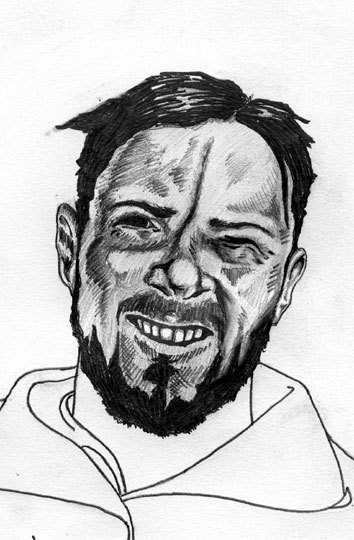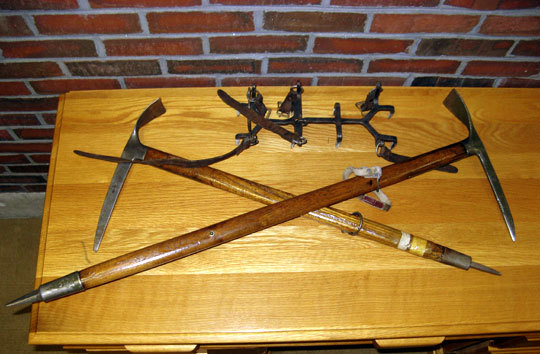
A drawing of Bates based on a photo taken in the mid-1940s, when Bates was testing mountaineering clothing and equipment for the US Army. Bates’ passing, on September 13, was a great loss to the climbing community. [Illustration] Jason Arkin
On September 13, 2007, the climbing community lost Robert Hicks Bates. Bates, 96, was a member of the “Harvard Five,” former president of the American Alpine Club, honorary member of the 10th Mountain Division and lieutenant colonel honored with the Legion of Merit and Bronze Star.
The mountains led Bob Bates across the world from Alaska and the Yukon, where he made numerous first ascents from 1932-1942, to Pakistan, where he made early attempts on K2, to Nepal and China, where he led an expedition that made the first ascent of Ulugh Muztagh in 1985, at age seventy-four.
He also authored and edited mountaineering literature, including Five Miles High (1939), K2: The Savage Mountain (1954) and his autobiography, The Love of Mountains is Best (1994). The italicized passages that follow have been excerpted from The Love of Mountains is Best in tribute to his long life of climbing in, and living for, the mountains.

A view of the St. Elias mountains, where Bates established numerous first ascents and named various uncharted features between 1932 and 1942. Bates’ infamous first ascent of Mt Lucania (17,150′), which was the highest unclimbed peak in North America at the time, became widely known through the David Roberts story, “Escape from Lucania.” [Photo] Courtesy of Tom Weber
Bob Bates was born in Philadelphia on January 14, 1911, and grew up with a family that encouraged interest in travel, literature and the outdoors.
On a pleasant summer day when I was five, my father, mother and brother, took me on my first climb. Flying Mountain rises 284 feet above sea level at Southwest Harbor on the Maine coast. That day its broad granite ledges were loaded with ripe blueberries and the air was fresh, with a slight breeze off the ocean, the salt air blending with the fragrance of sweet fern and spruce. From the summit the world stretched away and away… A deep love of mountains has been with me ever since. (Page 1)
That love blossomed on New England’s greater peaks, in the White Mountains of New Hampshire and on Katahdin in Maine. At Harvard, which Bates attended from 1929-1935 (earning a bachelor’s degree in 1933 and a master’s two years later), mountaineering became one of his core interests. His connections with Charles Houston, Bradford Washburn, Adams Carter and Terris Moore–they forged lifelong friendships and later became known as the “Harvard Five”–gave Bates experienced partners for innumerable jaunts to the Northeast’s familiar crags and peaks. These outings, although not seen as training, were learning opportunities for Bates and his partners.
Washburn was fond of the White Mountains, as was Everett, and soon the three of us were making frequent weekend trips to Pinkham Notch in Brad’s Model-A Ford Roadster, named Niobe… What he knew about climbing seemed endless. He was excellent company, too, with boundless energy and a good sense of humor. No wonder I didn’t mind the five-hour drives… (Page 8)
The experience from these outings, and the camaraderie among friends, led them abroad into the greater ranges, particularly to the Karakoram, and at “home” in the most uncharted areas of North America, in particular the St. Elias Range. In 1937 Bates and Washburn, along with Russell Dow and Norman Bright, climbed Mt. Steele and Mt. Lucania, which was North America’s highest unclimbed peak at the time (17,150′). It was also one of the continent’s most inaccessible: the team walked more than 100 miles over glaciers and rugged terrain.

The south face of K2 (28,250′), the world’s second-highest mountain, looking relatively benign. Bates and fellow Harvard student Charles Houston made two early attempts on this peak in Pakistan’s Karakoram, in 1938 and 1953. Both were epic–the first involved a 350-mile trek to the base and failed due to storms and lack of food; the second killed their partner, Art Gilkey, in one of the most famous mountaineering incidents in history. The first ascent was made in 1954 by an Italian team via the same proposed route, the Abruzzi Ridge, which follows the prominent vertical buttress on the right side of the photo up to the east ridge. [Photo] Courtesy of Adam Jacob Muller
Three months after his return from Lucania, Bates was invited by his Harvard friend, Charles Houston, to join the first American expedition to K2 (28,250′). In July of 1938–when no 8000-meter peak had yet been summitted–the team (Bates, Houston, Paul Petzoldt, Bill House, Dick Burdsall, Captain Norman Streatfeild and a number of porters) made a 350-mile trek and glacier travel from Srinagar to K2, where they decided the best option was to attempt the mountain from the southeast, on the Abruzzi Ridge. They reached the high point on the mountain (ca. 26,000′–this also was the worldwide highpoint for any American at the time) via that ridge, but poor weather and a lack of food kept them from the summit.
If perfect weather could have been guaranteed, there might have been time to establish two more camps and to reconnoiter a route to the summit, but this would have left only two or three days for the descent, an impossibility in storm. Great ominous columns of threatening clouds already loomed to the south. With this fact facing us, we made a decision: to pack a camp for two men to the highest point Paul and Charlie had reached, from where the next day, weather permitting, they would have a chance to move as high as they could, with the hope that they would get far enough at least to see a route up the summit cone. The plan meant giving up our hope to reach the summit, but at least we would extend our route up the mountain.
Deciding to abandon our plan to gain the summit was the hardest decision of the whole expedition, because climbing the mountain was the aim of all of us. After discussion, however, we all sadly agreed that going down was the right action. If we had known then how many climbers on K2 in a similar position to ours would die in later years because they failed to descend before a major storm, our decision would have been easier to make. (Page 137)

On disply in the Robert H. Bates Mountaineering Collection are the boots and hand-knit wool socks worn by Mr. Bates during the 1938 K2 summit attempt and an original down parka created by Eddie Bauer for the 1953 K2 attempt. In addition the collection contains photographs, newspaper clippngs, and climbing gear; all relating to Mr. Bates extensive mountaineering career. We thank the Phillips Exeter Academy Library for this photo.
[Photo] Courtesty of Joseph Montibello
Bates, Houston and six other climbers were involved in another attempt on K2 in 1953, one year before the mountain’s first ascent. They nearly reached their highpoint of 1938 when a massive storm and an ill teammate forced their retreat. They descended, pulling Art Gilkey behind them; Gilkey had developed thrombophlebitis, and soon blood clots were entering his lungs.
During their descent an enormous avalanche caused a series of unfortunate slips and rope tangles that led to “the most famous belay in mountaineering history.” One rope team was ripped down by the avalanche, entangling and pulling down the three lower teams. Art Gilkey was lost; the remaining six were saved from sliding off onto the glacier, thousands of feet below, by the twists in the ropes that led to Pete Schoening, the only climber who had managed to stay in one place. Gilkey’s body was found forty years later, four miles from the scene.
We were numbed by what happened. Art was gone. It didn’t seem possible that he had been swept away without a trace from the “escape route”… We shouted, but the only answer came from the wind.
…Now he was gone, and it was obvious that we had the fight of our lives ahead to get ourselves down, including the injured, the extent of whose hurts was not yet clear. (Page 283)

Lhasa’s marketplace, The Barkhor. Bates and his wife, Gail, spent time in Kathmandu between 1961-1963. When they returned to the US, Tsering Yangdon, a refugee from this town, accompanied them and studied at the University of New Hampshire. [Photo] Courtesy of Nathan Freitas
For most of his life, Bates was a teacher and a climber. In his mid-seventies Bates led an expedition that made the first ascent of Ulugh Muztagh in China. But perhaps more notable than his climbing accomplishments are his human ones.
Bates joined the US Army in 1941, before the United States entered World War II. No stranger to harsh conditions in cold climates–and poorly insulated clothing–Bates was assigned to the Office of the Quartermaster General. There he managed the testing and improvement of equipment and clothing to be used by the Army’s mountain divisions. (He and an “Alaskan Testing Team” also managed to sneak in the third ascent of Denali in 1942.)

These tools are a part of the Robert H. Bates Mountaineering Collection at Phillips Exeter Academy, where Mr. Bates was an instructor from 1939 to 1976. The collection offers more than 500 titles on the history of mountaineering in the last two centuries. We thank the Phillips Exeter Academy Library for this photo.
[Photo] Courtesy of Joseph Montibello
He spent more than a year in Kathmandu directing the first Peace Corps volunteers project. When he and his wife, Gail, left for the States, they encouraged a Tibetan refugee from Lhasa, Tsering Yangdon, to return with them and study at the University of New Hampshire. She was embraced by the Bates’ and was taken in as part of their family.
Those who knew Bates describe him as a perpetual teacher, one who did not climb or live for himself alone. His civil outreach in local communities of New England, for example in Exeter, New Hampshire–where he studied, taught and died–was as strong as his passion for the mountains he best loved and shared.

Denali (20,320′), Alaska Range, Alaska. Bates led a group of mountain soldiers up the peak for its third ascent in 1942. They were testing cold weather/high mountain clothing and equipment, a program Bates governed. [Photo] Courtesy of National Park Service
Bates is survived by his wife, Gail (Oberlin) Bates, two nieces, three great-nieces, two great-nephews, two great-great-nephews, and Tsering Yangdon and her son, Nima Taylor.
Check this Weekly Feature again, as it will be updated with more photos of Bates and his adventures. Thanks to www.seacoastonline.com for much of the information.